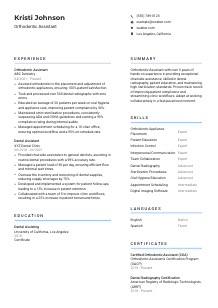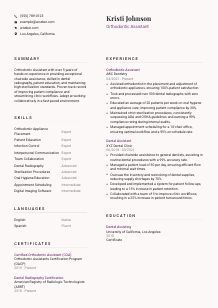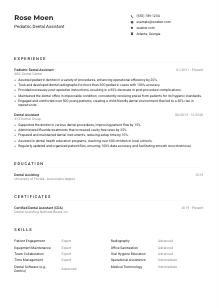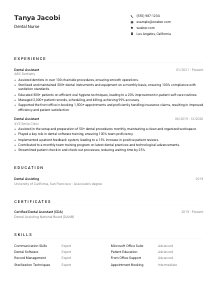Orthodontic Assistant Resume Example
Straighten those bullet points, but your resume feels misaligned? Delve into this Orthodontic Assistant resume example, formatted with Wozber free resume builder. Learn how to present your dental dexterity to fit the job, so your career can align with each patient's beaming smile!

How to write an Orthodontic Assistant resume?
Hello, aspiring Orthodontic Assistant! In the realm of orthodontics, where precision and care create smiles, your resume is your first step to making a lasting impression. With the help of Wozber's free resume builder, crafting an ATS-compliant resume that reflects your expertise and aligns with your dream job's requirements is simpler than ever.
Ready to embark on a path that leads right to the orthodontist's chairside? Follow this guide to ensure your resume is as polished as the smiles you aim to create.
Personal Details
The Personal Details section is your first opportunity to introduce yourself to potential employers. Here's how to craft this section for the Orthodontic Assistant position, ensuring it harmonizes with the profession's unique nuances and the job's specific requirements.
1. Name Recognition
Your name is the banner under which your professional reputation sails; make it memorable. Choose a clear, professional font, setting the stage for the rest of your ATS-friendly resume.
2. Job Title Alignment
Including the specific job title "Orthodontic Assistant" beneath your name immediately signals to the hiring manager that your application is targeted and relevant. This direct match can also positively influence ATS optimization.
3. Essential Contact Info
A reliable phone number and a professional email format, like firstname.lastname@email.com, are non-negotiable. Mistakes here could mean missed opportunities, so triple-check for accuracy.
4. Location Matters
The job you're eyeing is in Los Angeles, California - make sure to list your city and state to confirm your local availability, or willingness to relocate, right at the outset.
5. Online Presence
If you have a LinkedIn profile or a personal webpage showcasing your professional achievements or certifications relevant to orthodontic assisting, include it. Just ensure everything is up-to-date and mirrors the professionalism of your resume.
Takeaway
Treat the Personal Details section as your professional handshake. Tailor it carefully, leaving out personal details that are unnecessary for the role. It's your first opportunity to align with the job's specifics and set a confident, professional tone.





Experience
The Experience section is where you prove your worth. For an Orthodontic Assistant, this means showcasing patient care, technical skills, and an impeccable track record of assisting in orthodontic procedures. Let's guide your hand in sculpting this critical part of your resume.
- Assisted orthodontist in the placement and adjustment of orthodontic appliances, ensuring 100% patient satisfaction.
- Took and processed over 500 dental radiographs with zero errors.
- Educated an average of 20 patients per week on oral hygiene and appliance care, improving patient compliance by 30%.
- Maintained strict sterilization procedures, consistently surpassing ADA and OSHA guidelines and earning a 99% compliance rating during internal audits.
- Managed appointment scheduling for a 10‑chair office, ensuring optimal workflow and a 95% on‑schedule rate.
- Provided chairside assistance to general dentists, assisting in routine dental procedures with a 99% accuracy rate.
- Managed a patient load of 30 per day, ensuring efficient flow and minimal wait times.
- Oversaw the inventory and restocking of dental supplies, reducing supply shortages by 70%.
- Developed and implemented a system for patient follow‑ups, leading to a 15% increase in patient retention.
- Collaborated with a team of 5 to improve clinic workflows, resulting in a 25% increase in patient turnaround times.
1. Understanding the Role
First, dissect the job posting. For the Orthodontic Assistant role, keywords like "orthodontic chairside assisting" and "dental radiographs" are golden tickets for ATS optimization and should mirror in your resume.
2. Role Structuring
Lay out your professional experience in reverse chronological order, accentuating your most recent and relevant roles in the orthodontic field. Ensure each position listed includes the job title, the company, and the employment timeframe.
3. Highlight Achievements
Quantify your accomplishments where possible. Statements like "Assisted in the placement and adjustment of over 500 orthodontic appliances, ensuring 100% patient satisfaction," offer tangible evidence of your expertise and dedication.
4. Relevance is Key
Filter your experiences to highlight the skills and achievements most relevant to an Orthodontic Assistant role. This focus ensures your resume speaks directly to the needs outlined in the job description.
5. Numbers Speak Volumes
Within this profession, quantifiable achievements can set you apart. Whether it's the number of patients you've assisted, radiographs processed, or a perfect compliance rating with ADA and OSHA standards, these figures offer compelling evidence of your capability.
Takeaway
Your experience section is more than a log of your career; it is the story of your journey in orthodontics. Tailored correctly, it can vividly illustrate your competence and passion. Be selective, be quantifiable, and most importantly, be proud of your professional path. Remember, every bullet point is a chance to shine.
Education
In orthodontic assisting, your educational background lays the groundwork for your expertise. Here's how to mold your Education section to resonate with the specialized needs of the job, providing a solid foundation for your skills and experience.
1. Highlighting the Essentials
Start with the cornerstone of your qualifications: your high school diploma, followed by your specialized training. For instance, 'Certificate in Dental Assisting from University of California, Los Angeles' directly answers the job's call for accredited dental assisting program completion.
2. Structure for Clarity
Keep this section straightforward and accessible. Begin with your highest level of education, list any degrees or certifications pertinent to orthodontic assisting, and provide the name of the institution and your graduation date.
3. Tailored Degree Titles
If you've completed a specialized program or have a degree closely aligned with the role, such as a Certificate in Dental Assisting, make sure it's front and center. This directly relevant education speaks volumes to hiring managers.
4. Relevant Courses
Especially for early-career professionals, listing courses related to dental anatomy, radiography, or orthodontic science can be a plus. It shows a focused commitment to your field.
5. Additional Achievements
Include any distinctions or extracurricular activities related to dental or orthodontic assistance. This could be leadership in a study group, participation in community dental health programs, or relevant workshops attended. These details add depth to your educational background.
Takeaway
Your Education section is a testament to your preparedness for the Orthodontic Assistant role. It should succinctly communicate your qualifications and readiness to excel. Highlight your relevant educational achievements, making it clear that your foundation in this profession is both strong and specific.
Certificates
In the orthodontic world, continuing education and certifications are not just add-ons; they're essentials that demonstrate your commitment and expertise. Let's align your Certificate section with the profession's requirements, shining a light on your dedication to excellence.
1. Relevant Certifications
Start with certifications that echo the job posting's requirements. For instance, listing a 'Dental Radiography Certification' from the American Registry of Radiologic Technologists (ARRT) directly addresses a key job criterion, making your resume more ATS-compliant.
2. Quality Over Quantity
It's tempting to list every certification you've earned, but focus on those most relevant to an Orthodontic Assistant position. This strategic selection makes it easier for hiring managers (and ATS systems) to recognize your fit for the role.
3. Date Matters
Especially for certifications with expiration dates, such as CPR training, be sure to include the date of achievement. This detail underscores your commitment to keeping your skills and knowledge up-to-date.
4. Ongoing Learning
Highlight any recent or ongoing education, like webinars or workshops related to orthodontics. This demonstrates your proactive approach to professional development and keeps your resume fresh.
Takeaway
Your certifications showcase your specialized knowledge and ongoing commitment to your profession. Each one you list is a beacon of your dedication to excellence and continuous improvement. Carefully chosen and prominently displayed, they can significantly elevate your resume.
Skills
Your skills section is a concise showcase of your orthodontic arsenal. From technical prowess with dental instruments to stellar patient communication, let's ensure this part of your resume precisely matches the job's requirements and highlights your professional toolkit.
1. Dissecting the Job Post
Pull out the job description and identify both the hard and soft skills it seeks. Phrases like 'strong interpersonal skills' and 'proficient in dental radiography' are clues to what the employer values.
2. Mirror and Match
Align your listed skills with those found in the job description. This direct correlation not only makes your resume more relevant but also boosts your ATS optimization, ensuring your strengths are immediately noticeable.
3. Organized and Focused
Resist the urge to list every skill under the sun. Instead, choose the most impactful and relevant skills, organizing them with the most significant ones first. This strategic focus demonstrates your awareness of the role's demands and your capability to meet them.
Takeaway
Your skills section is your professional highlight reel. Each listed skill is a pledge of the value you bring to the orthodontic team. Keep it tailored, relevant, and aligned with the job description to show hiring managers that you're not just a match - you're the perfect fit.
Languages
In the field of orthodontics, where understanding and empathy are key, your ability to communicate in multiple languages can be a valuable asset. Let's tailor the Languages section to underline your communicative prowess, enhancing your resume's appeal.
1. Job Post Review
Identify if the job specifically requires proficiency in certain languages. In this role, 'Proficient in English for customer interactions' is a listed requirement, so make sure this is clearly addressed on your resume.
2. Prioritize and List
First, list English to reflect the job requirement, then add any additional languages you speak. Being multilingual in a field that deals directly with the public is a strong asset, showcasing your capability for broader communication.
3. Proficiency Clarity
Clearly indicate your level of proficiency for each language. Using terms like 'Native', 'Fluent', or 'Intermediate' provides hiring managers with immediate insight into your communication skills.
4. Appreciating Diversity
If the role involves interacting with a diverse patient base, highlighting language skills (even those not directly mentioned in the job post) can underscore your value as a culturally competent professional.
5. Honesty is Key
Be truthful about your language capabilities. Overstating your proficiency can lead to challenges down the line. Accurate representation ensures you can confidently engage with patients and team members alike.
Takeaway
Your language skills are more than a mere list; they're a testament to your ability to connect with patients and colleagues in meaningful ways. Highlighting your linguistic abilities emphasizes your readiness to engage with a diverse clientele, making you a valuable asset to any orthodontic practice.
Summary
A compelling Summary section introduces you in a way that resonates with hiring managers. For an Orthodontic Assistant, this means quantifying achievements, showcasing your specialty skills, and making a personal connection. Let's craft a Summary that opens doors.
1. Capturing the Essence
Begin by internalizing the job description. Understand what makes an Orthodontic Assistant indispensable - is it technical proficiency, patient care excellence, or both? Your summary should reflect these core values.
2. A Strong Introduction
Start with a brief introduction that encapsulates your professional identity and years of experience. Mentioning 'over 5 years of hands-on experience in providing exceptional chairside assistance' immediately establishes your credibility.
3. Highlighting Key Skills
Pinpoint the skills and accomplishments most aligned with the job's requirements, such as 'skilled in dental radiography' or 'maintaining high sterilization standards.' This concision makes your summary impactful and relevant.
4. Conciseness is Key
While it's tempting to detail every success, remember the summary is just a teaser. Aim for 3-5 lines that capture your professional essence and leave hiring managers eager to read on.
Takeaway
Your Summary is the bridge between your resume and your next job opportunity. Make it count by clearly aligning it with the role's essentials and showcasing your unique qualifications. This introduction is your chance to shine bright and set the stage for your comprehensive professional profile.
Embarking on Your Orthodontic Assistant Career
Congratulations on completing your guided journey to crafting an Orthodontic Assistant resume that stands out. Using Wozber's free resume builder, including its ATS-friendly resume templates and ATS resume scanner, you're now equipped to create a resume that doesn't just pass the automated screening but impresses the human eye, too. From the Summary to the Skills section, your resume is a polished reflection of your professional prowess.
Let it be the key that unlocks the door to your dream job. Your path to making a difference in dentistry, one smile at a time, begins now.

- High school diploma or equivalent.
- Completion of an accredited dental assisting program.
- Current certification in dental radiography.
- Minimum of 2 years of orthodontic chairside assisting experience.
- Strong interpersonal skills and ability to communicate effectively with patients.
- Proficient in English for customer interactions.
- Must be located in Los Angeles, California.
- Assist orthodontist in the placement and adjustment of orthodontic appliances.
- Take and process dental radiographs.
- Provide patient education on oral hygiene, appliance care, and post-treatment instructions.
- Maintain sterilization and infection control standards in accordance with ADA and OSHA guidelines.
- Manage appointment scheduling and patient records.















